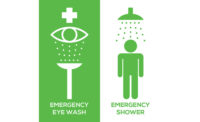Hundreds of deaths from coronary heart disease occur outside a hospital daily, according to OSHA, but up to 60 percent of those deaths could have been prevented if automated external defibrillators (AEDs) had been immediately available. Chances of survival from sudden cardiac death reduce by 7 to 10 percent for each minute without immediate CPR or defibrillation. After 10 minutes, resuscitation rarely succeeds, says OSHA.1
An AED is an electronic device designed to deliver an electric shock to a victim of sudden cardiac arrest. Ventricular fibrillation may be restored to normal rhythm up to 60 percent of the time if treated promptly with an AED -- a procedure called defibrillation. OSHA standards do not specifically address AEDs. However exposures to first-aid hazards are addressed in specific OSHA standards for the General Industry.
Steps to using an AED
The Red Cross offers OSHA-compliant AED training certification programs, but they also created a quick step-by-step guide to help workplaces review the AED steps whenever necessary.2
These AED steps should be used when caring for an adult, or a non-breathing child age eight or older who weighs more than 55 pounds.
After checking the scene and ensuring that the person needs help, you should ask a bystander to call 911 for help, then:
- Turn on the AED and follow the visual and/or audio prompts.
- Open the person's shirt and wipe his or her bare chest dry. If the person is wearing any medication patches, you should use a gloved (if possible) hand to remove the patches before wiping the person's chest.
- Attach the AED pads, and plug in the connector (if necessary).
- Make sure no one is, including you, is touching the person. Tell everyone to "stand clear."
- Push the "analyze" button (if necessary) and allow the AED to analyze the person's heart rhythm.
- If the AED recommends that you deliver a shock to the person, make sure that no one, including you, is touching the person – and tell everyone to "stand clear." Once clear, press the "shock" button.
- Begin CPR after delivering the shock. Or, if no shock is advised, begin CPR. Perform two minutes (about five cycles) of CPR and continue to follow the AED's prompts. If you notice obvious signs of life, discontinue CPR and monitor breathing for any changes in condition.
Safety considerations
There are some safety rules to keep in mind when using AEDs:3
- Do not use an AED when there is water present or the victim is wet. Electricity will take the path of least resistance, so if there is water on the chest then the shock will travel through the water instead of the heart muscle.
- No one should touch the victim during delivery of the electrical shock by an AED. The AED will instruct everyone to stand clear. As the operator you should repeat this command and ensure everyone is clear of the patient.
- An AED is delivering an electrical shock. Therefore there is always the risk of a spark. You should not use in AED in an explosive environment where there is a buildup of flammable vapors.
References







